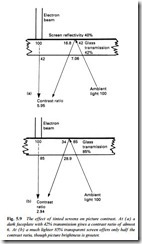PICTURE-TUBE NOMENCLATURE
The type numbers assigned to different designs of picture-tube have followed various formulae over the years. Tubemakers have now agreed on a worldwide type designation system which is detailed below:
FACEPLATE DESIGN
The darkest parts of a TV picture have the same luminance value as the (unenergised) screen itself, and the darker the faceplate can be made, the greater the perceived contrast of the picture: the ideal
viewing screen for a picture-tube would be a flat matt-black surface. In practice the nearest approach to this is to minimise the reflectivity of the screen to ambient light and phosphor light reflected back from the viewers and viewing area.
To this end the spaces between phosphors on the rear of the face- plate are filled with a light-absorbent black pigment based on carbon or graphite, a technology called black matrix. The phosphor mate- rial itself is very light in colour, so dyes are added to make each absorb incident light of colours other than its own. The use of these pigmented phosphors, together with black matrixing, reduces the reflectivity of the tube face by 30% or more without any effect on brightness. The benefit can be reaped in terms of either enhanced brightness or contrast, depending on the light transmission characteristic of the faceplate glass.
The faceplate glass characteristic makes an important contribution to picture-tube performance. In effect the glass viewing panel acts as a neutral-density filter, having grey glass with a light transmis- sion factor between 40% and 85%, depending on design. The basic idea of the dark-tinted faceplate, which inevitably reduces picture brightness, is to reduce the screen’s reflectivity and thus increase picture contrast. Reflected light has to pass through the glass twice, while the phosphor-light passes through only once. Thus for a face- plate with 50% transmission a four-fold reduction in reflected light is traded for a halving of the available light from the phosphors. Fig.
5.9 shows the effect of two different glass densities on the contrast ratio; the screen reflectivity factor is based on a modern design with pigmented phosphors and black matrix.
Screen shape
The transmitted picture is rectangular, and the more nearly rectangular the viewing screen the better. As picture-tube design progresses the screen is becoming ‘squarer’ and ‘flatter’ though it is difficult, in screen sizes larger than a few centimetres, to make them perfectly rectangular or completely flat due to the effect of atmospheric pressure on the glass envelope. Even so, Sony has produced large flat-screen tubes for consumer applications. The flat- ter the faceplate, the less ‘capture area’ it has for reflections from the viewing area, the wider its viewing angle, and the less distortion it gives to the picture.
Widescreen displays
In principle widescreen picture-tubes (16:9 aspect ratio) work in exactly the same way as the 4:3 tubes described above, and from which they were developed. The greater horizontal deflection angle imposes more stress on the horizontal output stage – and on the tube designer, whose yoke and gun assembly must be of high precision and close tolerance! For information on compatibility of standard and wide- screen pictures see page 212.

